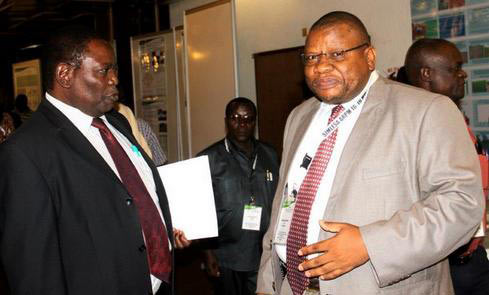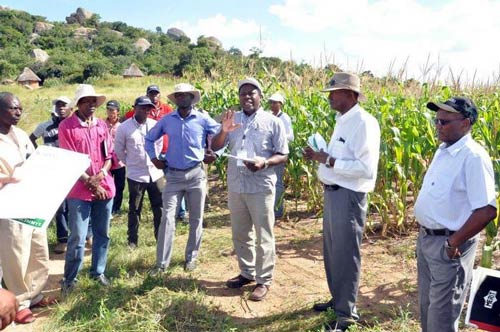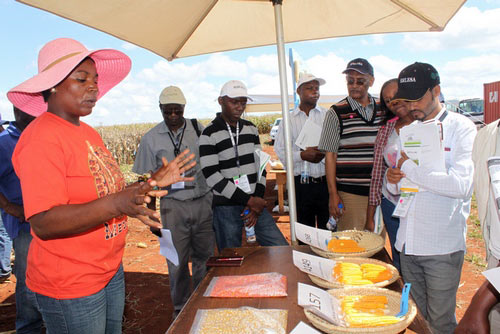
5th Annual Review and Planning Meeting to Strengthen Phase II

By Johnson Siamachira and Gift Mashango
Sustainable intensification through conservation agriculture (CA) is not only necessary but urgent. This is the key message and approach that SIMLESA is focusing on, in collaboration with its international partners and national agricultural research systems (NARS) in Africa.
About 120 SIMLESA partners, stakeholders and invited guests met in Harare, Zimbabwe, between March 16–19, to review activities to date and to plan for the 2015/2016 season. The second phase of the project (2014–2018) started in July 2014. Like Phase I, it is funded by the Australian Centre for International Agricultural Research (ACIAR) and managed by CIMMYT.
NARS project partners from SIMLESA’s core countries (Ethiopia, Kenya, Malawi, Mozambique and Tanzania) and spillover countries (Botswana, Rwanda and Uganda), attended this 5th Annual Review and Planning Meeting. Representatives from the Queensland Alliance for Agricultural and Food Innovation, the International Center for Tropical Agriculture, the International Livestock Research Institute (ILRI), International Crops Research Institute for the Semi-Arid Tropics and CIMMYT scientists from Africa and Mexico also attended the event-filled meeting.
Other participants included SIMLESA’s Project Management Committee, Project Steering Committee, donor representatives and senior Zimbabwe government officials.
The meeting was officially opened by Mr. Ringson Chitsiko, Permanent Secretary, Ministry of Agriculture, Mechanisation and Irrigation Development, Zimbabwe. He said the project had targeted increasing farm-level food security and productivity in response to the effects of climate risk and change. In addition, SIMLESA served as a model to many regional and subregional collaborative projects on agricultural intensification.

“In this respect, the challenge to NARS to develop agricultural technologies, information and knowledge that sustainably increase agricultural productivity, is very high,’’ said Chitsiko, adding that as government institutions, NARS from the different SIMLESA countries should play a critical role in integrated agricultural research and development. Chitsiko cited food production, economic growth and sustainable intensification as major avenues to unlocking Africa’s agricultural development opportunities. “Sustainable intensification of maize and legumes will increase resources productivity as well as reduce production risk,” he said.
Through the SIMLESA Project, smallholder farmers practice sustainable intensification principles, such as zero or minimum tillage, maize–legume intercropping, maize–legume rotations, growing new maize and legume varieties and appropriate fertilizer use.
The project has tested promising smallholder maize–legume cropping systems, attempted to increase the range of maize and legume varieties available for smallholders and facilitated strong capacity building for agricultural research partners, among other achievements.
Dr. Mulugetta Mekuria, SIMLESA Project Leader, said the second phase of SIMLESA would complement the achievements of the first phase (2010-2014), especially by scaling out good agricultural practices. Mekuria shared the objectives of the project’s second phase, including the continuation of the original 10-year vision with ambitions to sustainably improve maize and legume productivity of selected maize-based farming systems in each target country by 30 percent from the 2009 average, and reduce the expected downside yield risk by 30 percent for approximately 650,000 farm households. “We will also strengthen innovation platforms where farmers and agribusinesses have a platform to share market information, agronomic practices and other technologies,”Mekuria said.

At the four-day meeting, national coordinators from the five countries gave an overview of SIMLESA I products. Leaders of each of the four thematic areas highlighted the major changes to each area in SIMLESA II. Cross-cutting areas such as gender mainstreaming and communications were also highlighted as crucial to the success and impact for SIMLESA II. Participants streamlined their work plans and aligned them to country priorities, which were linked to country financial budgets.
Participants attended the CIMMYT–Southern Africa’s 30th anniversary celebrations. They also went on a field trip to Goromonzi and Murewa Districts in Mashonaland East Province where CIMMYT is implementing a research project on crop–livestock integration jointly with ILRI, the government of Zimbabwe, and local non-governmental organizations.
SIMLESA’s Project Steering Committee, composed of NARS leaders, independent Australian and African Co-Chairs, Project Management Committee Chair and the Project Leader, held a series of meetings to review the progress made and came up with recommendations.
Participants visited CIMMYT–Southern Africa Regional Office (SARO) research activities at its main research station outside Harare. CIMMYT–SARO showcased a wide range of breeding, physiology, agronomy and seed system activities. On-farm visits to the farming communities and partner seed research farm demonstrated CIMMYT’s involvement in technology development, testing and evaluation, and deployment to the ultimate beneficiaries. A series of presentations by other related sustainable intensification projects revealed areas of potential collaborations with SIMLESA. A panel discussion highlighted the project’s way forward and the importance of policy support in promoting sustainable intensification in Africa.
SIMLESA got coverage on the main news bulletins for three consecutive nights on national television station, following interviews with NARS leaders and the project leader. News and feature stories in national print media are expected to be produced in the coming few weeks. Here’s one for starters.
MORE PHOTOS: Meeting opening |Group photo